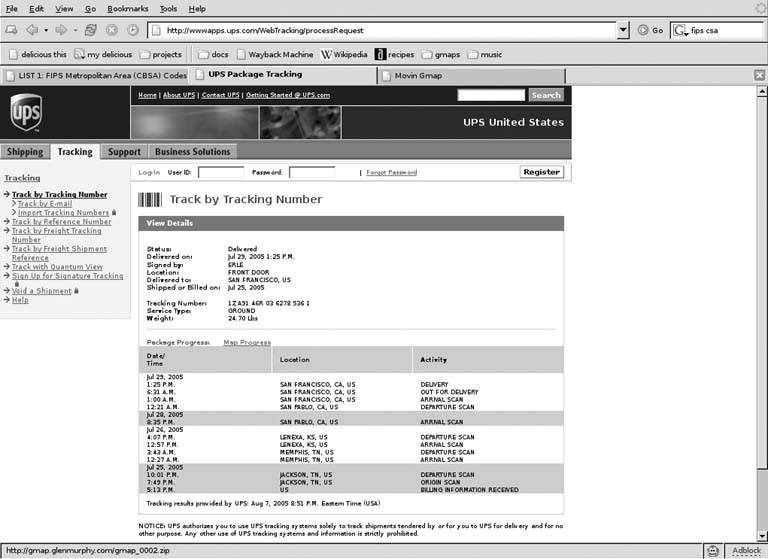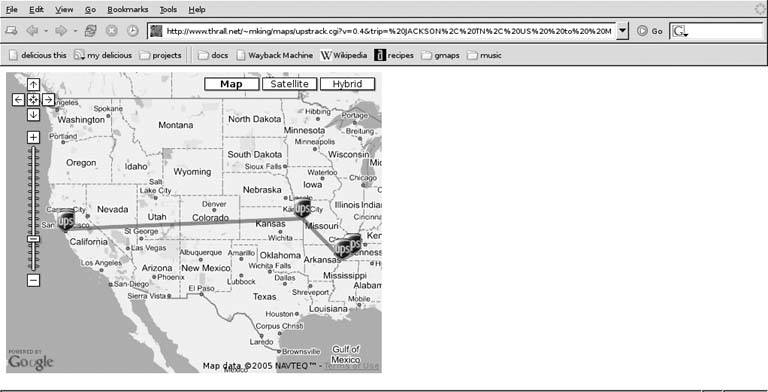Hack 25. Track Your UPS Packages


With Google Maps and a simple Greasemonkey user script, you can watch your UPS packages travel across the country.
Anyone who's received a package delivered by UPS, or any other large shipping company, probably has had the experience of wondering where the heck the package is right now, and when exactly it's going to arrive. By entering the package's tracking number into a form on the UPS web site, you can get back a list of the cities which the package has traveled through to date. Of course, this is enough information to allow us to visualize the package's progress on a map!
3.10.1. The Hack
As usual, the trick of mashing up Google Maps with information from another site, such as that from the UPS tracking form, involves a bit of contortion, to get around security restrictions in the browser. One solution to this problem (at least for Mozilla Firefox users) is to use a Greasemonkey user script to modify the contents of a web page to include a link to a map of the things on that page. The Greasemonkey approach [Hack #27] is exactly the one taken by Matthew King, when he decided he wanted to visualize the path traversed by his new laser printer, on its way from the warehouse to his hometown.
First, you'll need to be running Mozilla Firefox. You'll also want to install the latest version of the Greasemonkey extension from http://greasemonkey.mozdev.org/, if you haven't done this already; see "Add Google Maps to Any Web Site" [Hack #27] for more information on how this works. To install the UPS tracking user script, visit http://www.thrall.net/~mking/maps/upstrack.user.js in Firefox, and then select Tools images/U2192.jpg border=0> Install User Script from the menu bar. A confirmation window will pop up, in which you can simply click OK.
Now you're ready to track your UPS packages! Visit the UPS package tracking form at http://www.ups.com/content/us/en/index.jsx, enter a tracking number, click the checkbox to accept the terms and conditions of use, and then click the button marked Track. A summary page will load, with a "View package progress" link. Click this link as well. You should get a results page that looks something like Figure 3-16. This particular example shows the course of a box of O'Reilly's Mapping Hacks sent from the company's warehouse in Tennessee to our old house in San Francisco.
So far this looks just like the regular UPS package details page, with a list of cities, dates, and status messages. However, if you look closely, you'll see that the Greasemonkey script you installed earlier has added a special link to this page that reads simply "Map Progress." Go on, click it! A new window should open, showing a map of your package's progress across the country, as shown in Figure 3-17.
Figure 3-16. The UPS package tracking details page, augmented by Greasemonkey

Figure 3-17. The Google Maps representation of a package's travels

If you don't have a package of your own to track, you can always try out Matt King's example page at http://www.thrall.net/~mking/maps/ups_sample.html.
3.10.2. The Code
The Greasemonkey code for this hack is actually really simple and offers a good example of how to use Greasemonkey to pick elements from an existing page on the Web and use them to insert new elements into the same page. This first chunk of code from upstrack.user.js extracts all the locations from the UPS detailed results page:
var lastLoc = null;
var loc = null;
var locations = new Array;
var allDivs, thisDiv;
allDivs =
document.evaluate("//div[@class='modulepad']", document, null,
XPathResult.UNORDERED_NODE_SNAPSHOT_TYPE, null);
for (var i = 0; i < allDivs.snapshotLength; i++) {
thisDiv = allDivs.snapshotItem(i);
var html = thisDiv.innerHTML;
html = html.split(/[
]+/).join(' ');
html = html.replace("
", '');
if (html.indexOf(', US') == -1)
continue;
loc = html;
if (loc == lastLoc)
continue;
locations[locations.length] = loc;
lastLoc = loc;
}
The code starts by creating an empty array of locations and then passes an XPath to Firefox's document.evaluate( ) method to find all of the HTML div elements of the class modulepad, which apparently contain the location strings. The script then iterates over each div node, extracting the location string, cleaning it up a bit, and then pushing it on to the array of locations, checking each one to make sure that it's not redundant with the locations already stored.
The next bit of code in the script handles the insertion of the Map Progress link into the results page:
if (locations.length > 1) {
locations.reverse();
var locStr = locations.join(" to ");
allDivs =
document.evaluate("//span[@class='brownbold']", document, null,
XPathResult.UNORDERED_NODE_SNAPSHOT_TYPE, null);
for (var i = 0; i < allDivs.snapshotLength; i++) {
thisDiv = allDivs.snapshotItem(i);
var html = thisDiv.innerHTML;
var estr = escape(locStr).replace(/ //g, '%2F');
html += ' '
+ '<a href="http://www.thrall.net/~mking/maps/upstrack.cgi?
+ v=0.4&trip= + estr +
" target="_blank">Map Progress</a>';
thisDiv.innerHTML = html;
}
}
In this section, the code checks to see if any locations were found, and, if so, joins them with the string "to", yielding something like NASHVILLE TN to KANSAS CITY MO to SAN FRANCISCO CA in the locStr variable. The script then looks for div elements of the class brownbold, which presumably holds the "Package Progress:" text displayed on the page above the list of locations, and inserts a link to Matt King's http://www.thrall.net/~mking/maps/upstrack.cgi script into the div's innerHTML, passing a URL-escaped rendition of locStr as an HTTP GET parameter. This results in the Map Progress link that you can click to show the map in a new browser window. The server-side script geocodes each location and returns a Google Map with markers based on the UPS logo over each location, with colored polylines connecting themthus describing the path of your package.
3.10.3. Hacking the Hack
You'll note that this code also ensures that the location is within the United States, which means it won't work if the package's origin or destination is outside the States. If you live outside the U.S. (and are feeling adventurous), you might try removing or commenting that line out in your local copy of upstrack.user.js (buried somewhere in your Mozilla user directory) and then restarting Firefox to see if it does indeed work for you.
You Are Here: Introducing Google Maps
- Hacks 19: Introduction
- Hack 1. Get Around http://maps.google.com
- Hack 2. Find Yourself (and Others) on Google Maps
- Hack 3. Navigate the World in Your Web Browser
- Hack 4. Get the Birds-Eye View
- Hack 5. Driven to a Better User Interface
- Hack 6. Share Google Maps
- Hack 7. Inside Google Maps URLs
- Hack 8. Generate Links to Google Maps in a Spreadsheet
- Hack 9. Use del.icio.us to Keep Up with Google Maps
Introducing the Google Maps API
- Hacks 1016: Introduction
- Hack 10. Add a Google Map to Your Web Site
- Hack 11. Where Did the User Click?
- Hack 12. How Far Is That? Go Beyond Driving Directions
- Hack 13. Create a Route with a Click (or Two)
- Hack 14. Create Custom Map Markers
- Hack 15. Map a Slideshow of Your Travels
- Hack 16. How Big Is the World?
Mashing Up Google Maps
- Hacks 1728: Introduction
- Hack 17. Map the News
- Hack 18. Examine Patterns of Criminal Activity
- Hack 19. Map Local Weather Conditions
- Hack 20. Track Official Storm Reporting
- Hack 21. Track the International Space Station
- Hack 22. Witness the Effects of a Nuclear Explosion
- Hack 23. Find a Place to Live
- Hack 24. Search for Events by Location
- Hack 25. Track Your UPS Packages
- Hack 26. Follow Your Packets Across the Internet
- Hack 27. Add Google Maps to Any Web Site
- Hack 28. How Big Is That, Exactly?
On the Road with Google Maps
- Hacks 2941: Introduction
- Hack 29. Find the Best Gasoline Prices
- Hack 30. Stay Out of Traffic Jams
- Hack 31. Navigate Public Transportation
- Hack 32. Locate a Phone Number
- Hack 33. Why Your Cell Phone Doesnt Work There
- Hack 34. Publish Your Own Hiking Trail Maps
- Hack 35. Load Driving Directions into Your GPS
- Hack 36. Get Driving Directions for More Than Two Locations
- Hack 37. View Your GPS Tracklogs in Google Maps
- Hack 38. Map Your Wardriving Expeditions
- Hack 39. Track Your Every Move with Google Earth
- Hack 40. The Ghost in Google Ride Finder
- Hack 41. How Google Maps Got Me Out of a Traffic Ticket
Google Maps in Words and Pictures
- Hacks 4250: Introduction
- Hack 42. Get More out of What You Read
- Hack 43. Dont Believe Everything You Read on a Map
- Hack 44. You Got Your A9 Local in My Google Maps!
- Hack 45. Share Pictures with Your Community
- Hack 46. Browse Photography by Shooting Location
- Hack 47. Geotag Your Own Photos on Flickr
- Hack 48. Tell Your Communitys Story
- Hack 49. Generate Geocoded RSS from Any Google Map
- Hack 50. Geoblog with Google Maps in Thingster
API Tips and Tricks
- Hacks 5161: Introduction
- Hack 51. Make a Fullscreen Map the Right Way
- Hack 52. Put a Map and HTML into Your Info Windows
- Hack 53. Add Flash Applets to Your Google Maps
- Hack 54. Add a Nicer Info Window to Your Map with TLabel
- Hack 55. Put Photographs on Your Google Maps
- Hack 56. Pin Your Own Maps to Google Maps with TPhoto
- Hack 57. Do a Local Zoom with GxMagnifier
- Hack 58. Find the Right Zoom Level
- Hack 59. Show Lots of StuffQuickly
- Hack 60. Make Things Happen When the Map Moves
- Hack 61. Use the Right Developers Key Automatically
Extreme Google Maps Hacks
- Hacks 6270: Introduction
- Hack 62. Find the Latitude and Longitude of a Street Address
- Hack 63. Read and Write Markers from a MySQL Database
- Hack 64. Build Custom Icons on the Fly
- Hack 65. Add More Imagery with a WMS Interface
- Hack 66. Add Your Own Custom Map
- Hack 67. Serve Custom Map Imagery
- Hack 68. Automatically Cut and Name Custom Map Tiles
- Hack 69. Cluster Markers at High Zoom Levels
- Hack 70. Will the Kids Barf? (and Other Cool Ways to Use Google Maps)
EAN: 2147483647
Pages: 131
